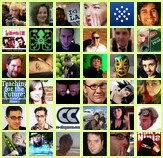In chatting with a few colleagues over coffee and at recent PRSA events, I’ve heard a common theme emerge: a distinct need for Twitter 101 for PR pros. For every David Mullen, Danny Brown or Sarah Evans that understands the nuances of Twitter and how to use it, there are thousands of PR pros out there that still just don’t get it. But, they want to learn.
Hey, I’m no Dave Fleet or Peter Shankman, but I think I have a decent understanding of the basics and I thought I’d share some of the tips and tricks I’ve learned along the way to getting started on Twitter:
* Knock off the basics first. Set up your account by clicking on the “Get Started” button on the main Twitter site. Fill out the basic contact information. Then, work out the details of your account:
* Find a good photo or head shot of yourself to use as your avatar. Make sure it’s a photo that makes you look approachable. Remember, Twitter’s kinda like online dating–people are going to follow others who look friendly and approachable. Plus, you want to put your best foot forward on behalf of your clients and the organization’s you represent (if that’s how you’re engaging).
*Don’t get too cute with your Twitter “handle” (name). I’d suggest the first name/last name approach. Keep it simple. Easier for others–including journalists and other key stakeholders–to identify you in the Twitterverse that way.
* Make sure you fill out the “Web” and “Bio” portions of your profile. For the “Web” link, use your LinkedIn profile if you don’t have a blog or Web site. Most folks want to know more about you when they follow you. Make it as easy as possible for them.
* Who to follow? Once you have your account/profile set up, start thinking about who you’d like to follow. There are a few ways to do this:
* Use Twitter Search. Easy way to find people with similar interests. Search by industry, product, service, etc. Find the people you want to connect and share with, learn from and listen to.
* Find journalists within your industry/areas of interest to follow. One good resource: http://mediaontwitter.pbwiki.com/. (thanks Sarah Evans!)
* If you read blogs in your industry/niche regularly, search the blog rolls for folks who might be on Twitter. Most bloggers have links to their Twitter page right on their blog.
* Raid the followers of your first follows. Once you’ve identified a few folks to follow, take a peek at the folks who follow them or people they follow. You can find this information on the right hand side under “Following.”
* If you’re in MN, and you’re looking for other PR tweeps to follow, you’ll find a slew of Twitter handles for local PR/communications pros using a list I recently created, which has been supplemented from folks across the Twin Cities.
* Lurk, then engage. OK, now you’ve got a few people to follow (and soon, hopefully a few followers of your own). Before you start engaging, I’d suggest “lurking” for a while. Maybe for a few weeks or so. Read other people’s tweets. Get to know them–read their bios and blogs (especially important with media–just like “offline” media relations). Just observe how others are acting and behaving on Twitter. After a few weeks, start posting your own tweets. But, make sure you have a strategy first. What kinds of information are you going to tweet? Will it be professional? Personal? A mix (what I recommend–humanizes you, makes you more approachable). How often will you tweet? More importantly, though, start responding to others. Do this by hovering over the right-hand side of each tweet. You’ll see a curved arrow–that’s the @ button. Click on that and you’ll reply to that person’s tweet. Keep in mind, if you go this route, everyone that’s following you can see your response. Want to keep it more private? Go with a DM. Find this button on the right-hand side under @Replies. By using DM, your tweet to that person is private and only they can view it (DMs more appropriate for pitches to journalists). Replies and DMs are the lifeblood of Twitter. Use them often to engage in conversations. I try to keep the 80/20 rule on Twitter. 80 percent of my time is spend replying and DMing fellow tweeps. The remaining 20 percent is spent generating my own tweets.
* Be yourself. Some of my favorite people in the Twitterverse are also some of the most funny–and I’ve never met them face-to-face. People like Danny Brown, David Mullen, Amber Naslund and Scott Hepburn crack me up daily. They also come across as real, genuine people. I think that has a huge impact on your success online–even if you are representing your organization. Don’t be afraid to share who you are. How do you pull this off? Create a mix of tweets that reflect your professional thinking and your personal life. The best way to connect with people is to give them a glimpse into your life. If they find something you have in common, they will reach out, connect and share.
Up next, Twitter 201–taking it to the next level (including using favorites, building communities and other Twitter applications to use).
Any additional tips for PR Twitter beginners? What’s missing from this list for first-timers?
Photos courtesy of: wboswell, seydoggy and Steve Woolf.




0 Comments